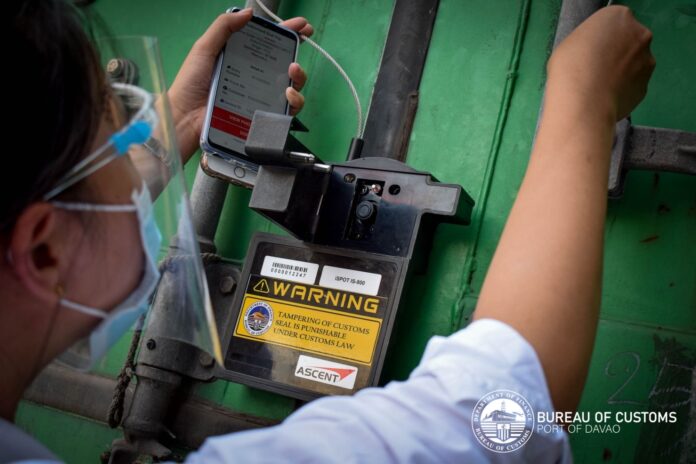-
The Bureau of Customs rolled out guidelines for adoption of the Electronic Tracking of Containerized Cargoes System on import and export cargoes for customs bonded warehouses
-
Starting March 1, E-TRACC will be fully implemented on export cargoes for CBWs at the ports of Batangas, Cagayan De Oro, Davao, and Subic
-
From April 4, the system will be 100% implemented for CBW exports at Cebu port and CBW imports and exports at the subport of Dadiangas
-
BOC officers responsible for processing import or export clearance will not approve any import or export Single Administrative Document without E-TRACC booking
The Bureau of Customs (BOC) rolled out guidelines for the adoption of the Electronic Tracking of Containerized Cargoes (E-TRACC) System on import and export cargoes for customs bonded warehouses (CBW).
According to Assessment and Operations Coordinating Group (AOCG) Memo No. 45-2022, E-TRACC will be fully implemented on CBW exports at the ports of Batangas, Cagayan De Oro, Davao and Subic on March 1.
From April 4, the system will be 100% in place for CBW exports at Cebu port and CBW imports and exports at the subport of Dadiangas in General Santos.
AOCG Memo 45-2022 directed concerned customs officers and offices to ensure all covered containers processed adhere to provisions of Customs Memorandum Order (CMO) No. 04-2020, which implements the E-TRACC System, as well as specific guidelines under the AOCG memo.
BOC examiners/appraisers or any authorized customs officers responsible for processing import or export clearance will not approve any import or export Single Administrative Document without the required E-TRACC booking as prescribed under CMO 04-2020.
Under AOCG Memo No. 45-2022, the transfer of full container load (FCL) and loose cargo load (LCL) container for export should be sealed with an electronic customs seal (ECS) before leaving the CBW to the port of loading.
The ECS is a GPS-enabled sealing device or lock capable of securing a container and providing real time location information.
FCL containers sealed with ECS from the CBW bound to the port of loading will no longer need underguarding.
Arming/affixing the ECS should be undertaken by the assigned customs warehouseman, while unsealing or disarming the ECS at the port will be undertaken by the Customs Container Control Division personnel.
For CBW imports, the transfer of FCL also requires an ECS before leaving the container yard at the port of discharge.
The transfer of LCL, meanwhile, should follow current rules and regulations and still be underguarded by warehouseman and/or customs guard to the client member warehouse/sub-contractors. This will be followed by the urgent need to disarm the ECS and to strip the container.
For CBW imports to miscellaneous bonded warehouses, AOCG Memo No. 45-2022 ruled that FCL containers should be sealed with an ECS and therefore will not need underguarding. The steps to unseal the ECS at the destination will be performed by the warehouseman or customs guard.
For CBW imports to common bonded warehouses, FCL containers bound from the port to the mother warehouse and to client member warehouse should also be sealed with an ECS.
In case of FCLs for garments, the warehouseman/guard, upon arrival of container at the mother bonded warehouse, will undertake the unsealing procedure.
For FCL containers for miscellaneous bonded warehouse, the warehouseman, upon arrival of the container at the mother bonded warehouse, should undertake visual evidence of the container and check if the ECS is still intact. After inspection, the truck carrying the FCL should then proceed to the member CBW, and the security guard assigned at the member CBW will again take visual evidence and transmit information to the concerned BOC office. The customs warehouseman/guard should then remove the ECS from the container once “end trip” is authorized by BOC.
E-TRACC is a Web-based system launched in 2020 to track the inland movement of containerized cargoes during transit and transfer to other customs territories and facilities. It allows BOC to track, monitor, and audit the location and condition of cargoes, as well as obtain real-time alarms on diversion and tampering of cargoes.
Several memos have been issued since 2020 on the gradual inclusion into the system of various economic zones, Freeports, and collection districts, and for imports, inter-island shipments, and CBWs. In August 2021, BOC held a public consultation on the proposed implementation of E-TRACC in all airports of entry.
Under CMO 04-2020, an ECS is required during the transfer of cargo to a container yard/container freight station or other customs facilities and warehouses; transit of cargo bound for Free Zones, inland customs offices, depots, or terminals; transit to CBWs; export of cargo from Free Zones, inland customs offices, depots or terminals, and CBWs to port of loading; and transfer of shipments subject to further verification or monitoring.
BOC said the trackers, or the ECS, are designed to emit an alert on any tampering to allow BOC’s Enforcement and Security Service Quick Reaction Team to act swiftly to prevent any smuggling activities.
All container vans covered by CMO 04-2020 should be affixed with an ECS before being cleared to depart from the starting point or point of discharge for the voyage to the end point or point of destination.
Except when warranted under CMO 04-2020, customs cargo clearance must be fully completed before any shipment can be sealed with an ECS.
Booking for an E-TRACC trip can be made one day earlier or up to one hour before departure of the container.
E-TRACC requires payment of P500 within a 10-kilometer radius from port of discharge and P700 beyond the 10-km radius from port of discharge. The charge covers both arming and disarming of the ECS. – Roumina Pablo





